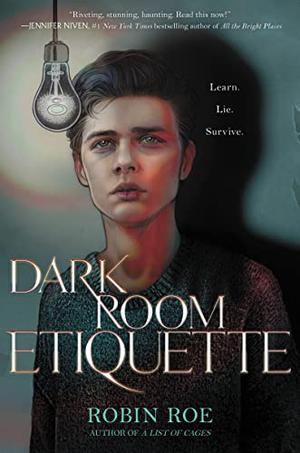Dark Room Etiquette by Robin Roe should be required reading for any student of psychology. Set in Texas, this is a powerful book about the aftermath of a traumatic event and illustrates how the human mind is a total mystery.
Roe tells the story of two years in the life of Sayers Wayte (Saye), a sixteen-year-old who turns eighteen in the course of the novel. As the story opens, Saye is basking in his status as a junior eligible for Homecoming Court at Laurel High School, as a popular young man with friends and a girlfriend, and as a member of the upper class whose money makes him reckless and virtually untouchable. In fact, Saye’s best friend Luke Solomon is concerned about Saye’s apparent boredom and lack of purpose. Saye also participates in various incidents of bullying behavior—not as the perpetrator but as a bystander. The most memorable of these is perpetrated against Evan Zamara.
Saye goes from living a fantasy to living a nightmare when he is abducted by a serial killer who believes Saye is his son, Daniel Emery who was taken at age ten. While in captivity in a windowless house, Saye recalls a lesson from his psychology course at school about the “horrors of solitary confinement in prisons” (158), which his teacher Ms. Wells refers to as legalized torture. “‘We’re social creatures,’ she said. ‘We need stimulation and human connection. Take that away from us, and we become depressed, even suicidal’” (159). While Saye is living that reality, he initially laughs at the fact that he always wished he “had a dad who actually gave a shit” (161). Now, he sarcastically thanks the Universe for giving him Caleb, who wants him so much he chains him inside his house so he can never leave. Over time, Saye both hates but learns to love the care and attention Caleb gives him.
As Saye struggles to survive, his only tools are will power and hope. A student of languages, Saye clings to the Latin phrase: “Alis grave nil—nothing is heavy to those who have wings” (196). He vows if he survives and manages to escape that he will learn how to give, not just to need and to take.
Readers accompany Saye on this tortured journey. We not only recognize how the mind can stay trapped even when the body is free but learn what our minds will do to survive.
A subplot of Roe’s novel explores bullying behavior and how some people are “the kind that like to break things just to see them in pieces” (458). It is additionally about friendship and circumstances that contribute to endurance and erosion of those relationships.
Through her characters’ lives, Roe confirms that at a basic level, we all need to be needed. Her book’s moral further suggests that if there is even a chance that someone needs us and we have the capacity to help, we have to try.
- Posted by Donna

